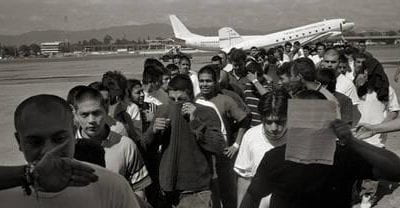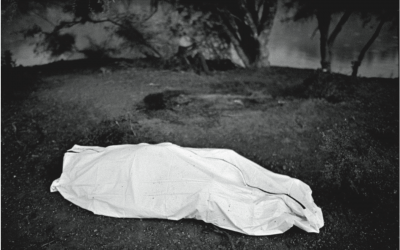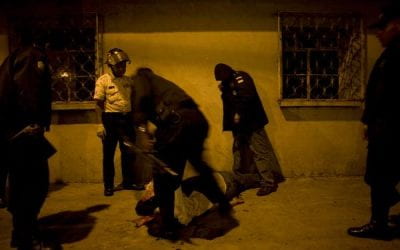The Zetas’ Bad Omen
From Mexico to Guatemala
In organized crime, the Zetas are like cancer. Once bad cells take a hold of an area, their metastatic nature soon spreads them in all directions. The Zetas defy smaller countries like Guatemala, where they reckon with weaker security forces than in neighboring Mexico. The new Guatemalan administration (which took office in January), led by a retired general, President Otto Pérez Molina, must now face this challenge.
Osiel Cárdenas Guillén, former head of the Gulf Cartel in Mexico, never envisioned the birth of a monster when he recruited Mexican military forces to watch his back. In 1998, he had got into fights with his closest business partners, some of whom he ordered killed, sometimes over women, sometimes over money. It didn’t come as a surprise that his nickname was Mata-amigos (“Friend killer.”) Osiel’s ally against his enemies was Arturo Guzmán Decena (a.k.a. Zeta 1), a member of the Mexican Airborne Special Forces Group (Grupo Aeromóvil de Fuerzas Especiales, GAFES). GAFES was set up to fight the Zapatista guerrillas in Chiapas, in the early 90s, and was allegedly trained by the Guatemalan elite military squad, the Special Kaibil Forces.
Feeling rather vulnerable, Osiel asked Zeta 1 (an expert in military intelligence, espionage and explosives) to recruit a group of trustworthy men to keep him safe. Guzmán Decena turned to his peers in GAFES. Osiel soon trusted them with several plazas, or posts, along the Mexican Atlantic coast and the border with the United States. The Zetas took on the challenge like bullets fitting into a gun.
Osiel was not the product of a traditional organized crime family, but he had muscled his way into the empire built by one: the Gulf Cartel. By 1997, he owned the crime franchise in Tamaulipas and the Gulf of Mexico, and picked up South American drug shipments from his contacts in Chiapas, Mexico, and Guatemala. One year later, he was armored by Zetas. But in 2003, Osiel was arrested.
According to Mexican author Ricardo Ravelo, the Zetas turned the Gulf Cartel into a strong rival of the Sinaloa Cartel, expanding toward Central America. Osiel nodded approvingly in jail. Shortly after, in late 2006, President Felipe Calderón took office in Mexico. The following year, Osiel was extradited to the United States, and the Zetas began branching out from the Gulf Cartel. By then, Eduardo Costilla, a.k.a. El Coss, shared the cartel’s leadership with Osiel’s brother, Antonio Ezequiel Cárdenas, a.k.a. Tony Tormenta (“Storm,” killed in 2010).
The Zetas worked for the Gulf Cartel and operated on their own. In 2007, one of their actions went awry in Honduras. An ambush ended in a stolen shipment and two of their own were killed, according to military intelligence sources in Mexico and Honduras. The Zetas tracked down the culprit and found Juan José León, a.k.a. Juancho in Zacapa, a Guatemalan province bordering Honduras. He was married to Marta Lorenzana, from a family that the U.S. Department of Justice (USDOJ) links to the Mexican Sinaloa Cartel. Months later, Juancho realized—too late—that he had made a fatal mistake.
Zetas Rule
The decapitation of 31 victims at the hands of the Zetas in May 2011 produced international news headlines announcing Mexican traffickers’ move to Central America. However, the Mexicans had operated in Guatemala since the late 80s, and grew stronger a decade later, after the demise of the large Colombian cartels.
Prior to 395 BC, Greek historian Thucydides wrote that a stricken empire must retaliate (even if not against the aggressor) to prove it’s not defeated. In 2007, after the Honduras fall out, the Zetas had a lesson to teach—and territory to colonize.
They raised their first colonization flag in Zacapa, after allegedly persuading the Lorenzana family to turn Juancho in. Juancho, a source of trouble bcause of his habit of stealing shipments, was then tricked into willingly walking to his death. Ten others killed included his bodyguards and several aggressors. The police eventually arrested 14 Zetas (all convicted in 2010). Half were Mexican; the rest, Guatemalan. It also found revealing evidence about their operations.
Mexican Zetas had entered Guatemala through Huehuetenango (on the border with Chiapas) in 2007. Flight plans showed they boarded charter planes to Alta Verapaz, a province with access to northern and southern Guatemala. That destination proved critical for their partnership with a strong local trafficker, Walther Overdick, known for moving up to two tons of cocaine at a time.
After raiding their hideouts, authorities found a trail of invoices describing the Zetas’ roadmap to Juancho’s murder. From Alta Verapaz, they had gone to the southern coast, where several municipalities issued them Guatemalan identification cards. They continued on to the capital, to buy motorcycles and cars. Two men stayed in the Intercontinental Hotel, seven blocks away from the U.S. Embassy. Another one stayed in the Panamerican Hotel, two blocks from the National Palace and the presidential offices. Others stayed in rented houses in the outskirts of the city.
The March 25, 2008, attack caught authorities off-guard, and landed the Zetas their first headlines. The weapons seized from them included grenade launchers, an anti-tank weapon, assault rifles and two Beretta 92FS 9mm pistols—among other handguns—whose purchase was tracked down to a store in McAllen, Texas, in December 2007.
An Invisible Head
The killing of Juancho interested the U.S. Embassy in Guatemala. One cable dated March 28, 2008 (Ref #08GUATEMALA387), warned that one of the arrested Mexicans, Roberto Rodríguez Cárdenas, was “associated with Miguel Angel Treviño Morales of the Gulf Cartel in Mexico.” The document revealed that “DEA sources suggest[ed] that this attack could signal a possible move by Mexican drug trafficker Treviño Morales to take control of Central American drug trafficking, specifically in Guatemala, Honduras and El Salvador.” He was the second head of the Zetas, after Heriberto Lazcano, a.k.a. El Lazca, in Mexico.
Guatemalan prosecutors and police instead focused on Mexican-born Daniel Pérez Rojas, a.k.a. Cachetes (“Cheeks”), arrested in April 2008, in connection with the Zacapa massacre. But by July 2009, Treviño Morales—a.k.a. Zeta-40, or Comandante Forty—was placed among the most “significant traffickers” under the Drug Kingpin Act, by the U.S. Office of Foreign Assets Control (OFAC). The list included El Lazca, El Coss, and, one year later, Pérez Rojas.
Treviño is wanted on drug trafficking charges in a Washington D.C. court since March 2008, and several murder charges in Texas since 2007. The U.S. Department of State offered a reward of $5 million for information leading to his arrest. Yet, Comandante Forty remained incognito even after a bloody Zeta-Sinaloa Cartel shootout left 17 dead in November 2008 in Huehuetenango.
In February 2009, a U.S. Embassy cable (Ref#09GUATEMALA106) reported that police found three checks made out to Guatemalan Army Colonel Carlos Mancilla (now former Deputy Chief of Staff) while searching Overdick’s home. Unofficial government sources also identified a retired defense vice-minister allegedly responsible for supporting Zeta logistics in the area.
In March, authorities found a Zeta training camp in Quiché, a province neighboring with Alta Verapaz. “It was only accessible by helicopter,” then president Álvaro Colom said. The Zetas used it for shooting practice, and had left behind grenades, ammunition and firearms.
In April, five counternarcotics detectives were gunned down in a Zeta bodega in Amatitlán, 11 miles from the capital. Immediate retaliation followed. More than 500 grenades, ammunition and weapons were seized, some of military manufacture that had been illegally extracted from a military warehouse.
Domino Effect
By January 2010, El Lazca led the Zetas in Mexico after Guzmán Decena and other leaders were killed. That month El Coss had ordered the execution of Victor Peña (a.k.a. Concord 3), the cartel’s financial operator, and also a compadre of Treviño. Comandante Forty took it personally and demanded that the killers be turned over to him. After El Coss refused, Treviño declared war against the Gulf Cartel and took over its plazas in Mexico and Guatemala. In April 2010, a former federal agent confirmed the U.S. Embassy’s earlier suspicion: “Treviño was the strongest man in drug trafficking in Guatemala.”
Once the Zetas became a liability, the Gulf Cartel partnered with the Sinaloa Cartel. But the Zetas reproduced a model that the Gulf Cartel had practiced for decades in Mexico. The organization was a toll booth of sorts, collecting fees from criminals who operated in its turf. It also extorted and kidnapped. Some targets included undocumented migrants, a trend grossly exposed when 72 Central and South Americans were found dead in Tamaulipas in August 2010.
Violence is used in the absence of power, in the words of Hannah Arendt, and the Zetas did just that. Lacking popular authority of traditional narco families (which bought communities’ silence by building clinics or paving streets, using selective violence when needed), the Zetas took territory by force.
In October 2010, a caravan of 20 cars and some 60 men caused havoc in Petén, in the north of Guatemala, engaging in a long shootout with a military and police patrol. The caravan entered through Belize, continued onto an El Naranjo ranch—allegedly searching for a cocaine shipment—and headed west to Mexico. According to authorities, the ranch’s owner was the widow of an alleged Juancho successor. The Zetas also vandalized property of rival traffickers. They were testing the waters for future actions.
Before October was over, a top government official admitted off-the-record that Treviño was (still) “the number one [man] in drug trafficking in Guatemala.” Despite mounting evidence, counternarcotics prosecutors insisted on never having heard of Comandante Forty.
A Long Zeta Arm
The Petén events didn’t prompt a state of siege like the discovery of 27 decapitated peasants did, on May 15, in a ranch near the Mexican border—a gruesome Zeta message to the property’s owner for allegedly trafficking for the Gulf Cartel. Ten days later, another bloody discovery ensued: the remains of prosecutor Allan Stowlinsky left in several plastic bags strewn around downtown Cobán, Alta Verapaz’s capital.
Written messages left near the bodies were signed by “Z-200,” whom Mexican authorities identified as Flavio Méndez Santiago after his January 2011 arrest in Oaxaca. Méndez was known to have visited Alta Verapaz in late 2010, and was linked to the kidnapping and murder of migrants in his native México. The written messages indicated that he ordered the killings in Petén and Alta Verapaz, even while imprisoned.
In mid-March Stowlinsky had helped to count 453 kilos of cocaine seized from the Zetas in Alta Verapaz, only weeks after a two-month state of siege in that province. One police officer, assigned to the area two days before the seizure, stopped the truck carrying the shipment. Minutes later he was threatened over his cell phone by what sounded like a Mexican male voice, according to former Minister of Interior Carlos Menocal. Before that, the phone had been kept only at police headquarters in Cobán.
In June 2011, Menocal said that one ton of cocaine was seized from the Zetas that year. It was 25 percent of the total amount seized by December, but didn’t necessarily reflect the Zetas cut in the market.
Michael Vigil, former Chief of International Operations for the U.S. Drug Enforcement Agency (DEA), said “It will be extremely difficult to immobilize [the Zetas] once they spread their tentacles into the political, social, and economic processes of Guatemala.” But some accounts indicate the Zetas might have done just that already.
In December 2010, a group claiming to be the Zetas barged into three radio stations in Cobán, and forced employers to read a message on the air. They accused President Colom of not keeping his word after receiving $11.5 million in late 2007 to protect the Zetas, and demanded an end to the state of siege. Coincidentally, the same former federal agent who spoke of Treviño earlier also recalled receiving information on the alleged deal with a $1.5 million difference. The source heard that the Zetas paid $13 million to an influential Guatemalan government official for protection, between 2007 and 2008. He didn’t know whether this money reached someone else—if anybody at all. Colom denied the allegations. However, it was puzzling that eight months before the radio announcement was heard in Alta Verapaz, the former federal agent had already heard about the alleged bribe.
By July 2011, authorities realized that the Zetas were partying in the training camp discovered in 2009, left without surveillance for two years. Police arrested 14 people, including Overdick’s son, Kevin. Videos found at the ranch showed that his father, other Guatemalan Zeta associates and one Mexican, had barely escaped the raid.
The same month, a financial operator for the Zetas was arrested in Antigua Guatemala—a touristic town, 30 miles from the capital, where Treviño also owns a home (as well as in Alta Verapaz), according to the former federal agent. To this day, Guatemalan authorities have yet to publicly identify Treviño as a Zeta leader and arrest the Zetas on the U.S. extradition request list.
The new administration of President Otto Pérez Molina faces two main security challenges. One is the Zetas. The second is increasing methamphetamine production in Guatemala, geared toward the Mexico, U.S. and Europe, and pushed mostly by the Sinaloa Cartel. So far, only Sinaloa Cartel Guatemalan associates requested in extradition by the United States for drug trafficking have been arrested in the last two years. Among the five more prominent are Waldemar Lorenzana Lima and his son Elio Lorenzana Cordón.
President Pérez Molina’s request for an increase in U.S. assistance to fight drug trafficking was met by conditions to improve performance and progress in human rights issues. But the new administration also expects that cracking down on corruption, and a tax reform, can generate more funds to fight crime—a feat in itself. Several members of the elite Kaibiles military squad (now totaling 1,600 active or retired graduates, according to a Kaibil instructor) have even joined the Zetas, but Pérez Molina intends to use the good ones left.
Menocal claims that the states of siege, and the arrest of nearly 100 alleged Zetas since 2008 (one third of them Mexican), cut crime rates in half. However, one military high official said the Zetas “became a threat difficult to control….[and] now it’s too late to tackle them directly with Guatemala’s poor technical resources and the poorly trained personnel.” According to Vigil, who is also an adviser for Mission Essential Personnel in Washington D.C., the Zetas have the potential of becoming a “national security threat to the region.”
Last October, the Zetas remained active in Petén, where Overdick has a strong operation base, the former counternarcotics military official revealed. In December, they were also visible in Alta Verapaz, according to Adela de Torrebiarte, current Commissioner for Police Reform. “They recruit idle youngsters dubbed Zetitas (little Zetas), who stand at street corners and warn them when outsiders enter Zeta territory,” she said. A civilian intelligence source said the Zetas also await to decide who they are going to do business with, or go to war with, in the new government.
One military official who led counternarcotics operations in the last administration said that the Zetas are good at “learning their lessons well.” And now, as in the Osiel days, authorities have difficulties to keep up the pace.
Spring 2012, Volume XI, Number 3
Julie López, a freelance journalist in Guatemala who writes frequently for Plaza Pública, recently wrote a report for the Woodrow Wilson International Center for Scholars in Washington DC titled “Guatemala’s Crossroads” <http://www.wilsoncenter.org/events/docs/Lopez.Guatemala.pdf>. In 2011, she was the recipient of a Woodrow Wilson Center-Washington Post Fellowship. In 2010, she won the Félix Varela Award for print journalism for her series “The Narco Empire,” published by El Diario La Prensa in New York.
Related Articles
Transmigration in Mexico
English + Español
En abril del 2010 una delegación oficial de El Salvador encabezada por Francis Hato Hasbún, el Secretario de Asuntos Estratégicos del gobierno del Presidente Mauricio Funes, visitó México…
Organized Crime as Human Rights Issue
English + Español
It was a horrifying scene— 72 people murdered all at once. One survivor bore witness to the massacre. The dead were migrants, mostly Central Americans; 58 men and 14 women trying to…
First Take: Organized Crime in Latin America
English + Español
Dealing with transnational organized crime is now an official part of U.S. security strategy.
A strategy document, issued by the White House in July 2011, speaks of organized crime groups…




